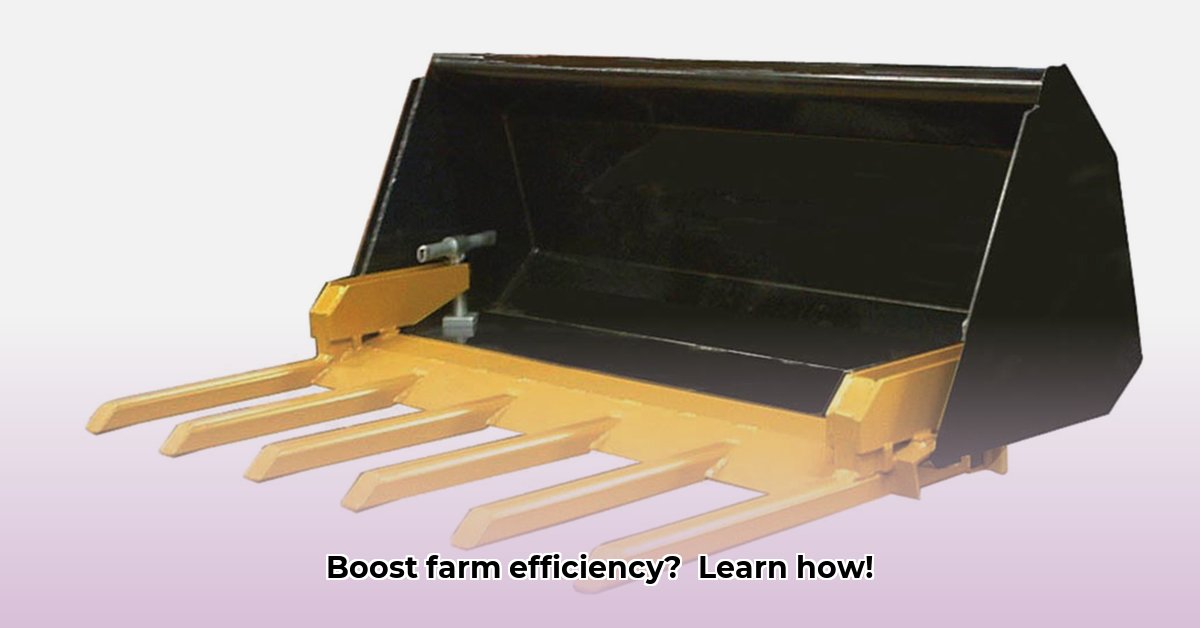
Tractor debris forks are transforming post-harvest cleanup, offering a blend of efficiency, safety, and sustainability. This guide provides actionable steps to help farmers, agricultural managers, equipment manufacturers, and researchers determine if a debris fork is the right tool for their operation. For removing rocks, consider alternative methods.
Getting Started with Tractor Debris Forks
Tractor debris forks are heavy-duty attachments that mount onto your tractor's loader, enabling the rapid removal of post-harvest debris such as crop residue and plant material. This streamlined cleanup process significantly reduces labor demands and prepares fields for the next planting season. But careful planning is crucial before investment.
Assessing Compatibility: A Step-by-Step Guide
Ensuring compatibility between your tractor and the debris fork is paramount for safety and efficiency. Incompatible equipment can lead to damage and costly repairs.
Step-by-Step Compatibility Assessment:
- Consult Manuals: Review your tractor and loader manuals for weight limits, hydraulic capacity, and attachment compatibility.
- Payload Capacity: Select a debris fork with a payload capacity comfortably exceeding the anticipated weight of the heaviest debris. A safety margin is advised.
- Mounting System Verification: Confirm the debris fork's mounting system precisely matches your loader's attachment points.
- Test Fit and Trial Run: Perform a test fit and a trial run with a small load to ensure everything functions correctly.
The Advantages of Tractor Debris Forks
Implementing tractor debris forks offers several compelling benefits:
- Increased Efficiency: Faster cleanup translates to significant time savings, freeing up resources for other farm tasks. "We've seen a 40% reduction in field cleanup time since adopting debris forks," says Dr. Emily Carter, Agricultural Engineering, Purdue University.
- Enhanced Ergonomics and Safety: Tractor debris forks drastically reduce manual labor, minimizing the risk of back injuries and improving worker safety.
- Potential Fuel Savings: Fewer tractor passes may reduce fuel consumption, although the impact varies depending on several factors. Further research in this area is needed to quantify these savings.
- Environmental Sustainability: Efficient residue management minimizes soil disturbance and contributes to more sustainable farming practices. "Proper residue management is crucial for carbon sequestration and soil health," notes Professor David Miller, Soil Science, University of Illinois.
Potential Drawbacks to Consider
While benefits are substantial, several potential limitations should be addressed:
- High Initial Cost: Tractor debris forks represent a significant investment.
- Maintenance Requirements: Regular inspection and maintenance are critical to prevent breakdowns and extend lifespan. "Preventative maintenance is key; neglecting it can double your long-term costs," says John Davies, Farm Manager, Green Valley Farms.
- Storage Space: Adequate storage is necessary to prevent damage from exposure to the elements.
- Limited Compatibility: Thorough compatibility checks are imperative.
Optimizing Debris Fork Usage for Maximum Impact
Maximize the benefits of your debris fork with these strategies:
- Strategic Debris Placement: Plan your collection points to minimize travel time.
- Safe Loading Practices: Avoid overloading to prevent damage and ensure safe operation.
- Regular Maintenance: Establish and adhere to a regular maintenance schedule.
- Pilot Testing: Begin with a pilot test to assess effectiveness before full implementation.
Tractor Debris Forks and Sustainable Farming Practices
Efficient residue management is key to sustainable farming and reducing environmental impact. Tractor debris forks contribute to this effort in several ways:
- Improved Soil Health: Proper residue management promotes healthier soil, enhancing its ability to sequester carbon.
- Reduced Greenhouse Gas Emissions: Efficient residue removal minimizes methane and CO2 release from decomposition.
- Optimized Fuel Efficiency: Faster field operations reduce fuel consumption.
- Enhanced Nutrient Cycling: Strategic residue management improves nutrient recycling, potentially reducing the need for synthetic fertilizers.
Choosing the Right Debris Fork for Sustainable Farming
Selection should prioritize:
- Tractor Compatibility: Ensure compatibility with your tractor's hydraulic system and lifting capacity.
- Fork Capacity: Choose a capacity exceeding your anticipated residue volume.
- Fork Design: Consider tine spacing and material based on your residue type.
- Safety Features: Prioritize safety features such as overload protection.
Cost-Effectiveness and Long-Term Sustainability
While initial investment is substantial, the long-term benefits, including reduced emissions and improved soil health, often outweigh the costs. Explore government subsidies and grants to mitigate the initial investment.
Addressing Potential Limitations
- High Initial Investment: Explore financing options.
- Maintenance Costs: Invest in preventative maintenance.
- Learning Curve: Seek training and guidance.
Conclusion: Making Informed Decisions About Debris Forks
Tractor debris forks offer a compelling solution for enhancing farm efficiency and promoting sustainable practices. However, careful consideration of compatibility, cost, and maintenance requirements is crucial. Weighing the long-term benefits against initial investment will determine if a debris fork is a worthwhile addition to your operation. Remember, thorough planning and research are essential.